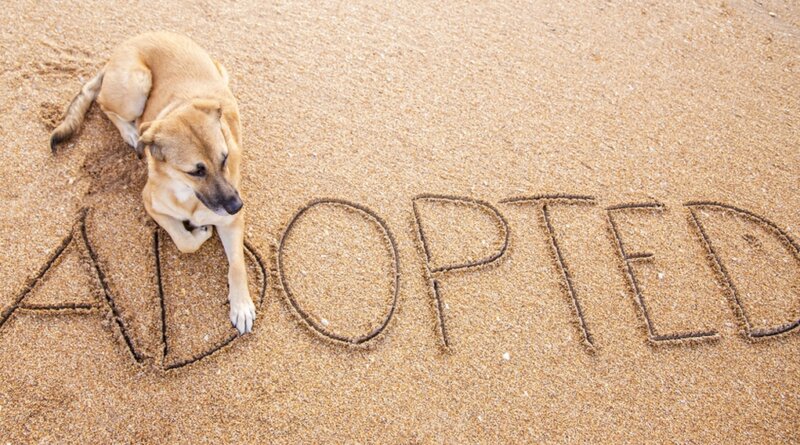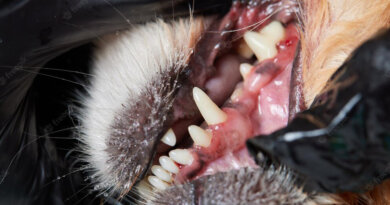26-Step Checklist for Adopting a New Dog or Puppy (How to Do It Right!)
Adopting a new dog is exciting, but if you aren’t prepared, it can also be exceptionally overwhelming.
Fortunately, the following new dog supplies checklist can make sure that you are ready to welcome your new four-legged family member with open arms!
Preparing for your new arrival should start weeks before you bring your new friend home.
You’ll need to do some research about dogs in order to choose the breed that will be best for your family.
You’ll also have to be sure that you can afford this new venture.
Dog food and toys won’t be your only expense.
You also need to think about grooming costs, veterinary care, and the expenses incurred for pet care when you go out of town.
Potential pet parents also need to be sure that they’ll have enough time to spend taking care of their dogs.
Don’t forget to plan for the time you’ll need to walk your dog, groom him and play with him.
There’s a lot that goes into adopting a new dog, like knowing how much a dog is going to cost you.
This new dog supplies checklist will help you make an informed decision.
Just remember not to get sucked in by those big round eyes and soft floppy ears when considering a new dog or adopting a puppy.
If it’s not the right time for you to adopt a dog, that’s okay.
You can use this checklist to plan for the future.
READ MORE: 50 Dog Adoption Questions They’re Going to Ask You
Before You Adopt
1. Talk to the whole family
Make sure that everyone is on board with getting a new dog and the responsibility that it will entail.
Even if you don’t think so now, you will need the help of other family members at some point.
2. Check with your landlord
If you rent your home, ensure that your lease allows for dogs and make sure that you can pay any deposits or pet rent that apply.
Not all places allow pets into houses and apartments, but there’s a way to improve your chances of being allowed.
3. Make a list of references
You need to find people that can be provided to the pet adoption agency.
Usually, three non-family member references are required for rescue organizations and animal shelters, or a reputable dog breeder.
If you have animal experts that you know, that would be even better.
4. Look at your finances
Make sure that you can afford a dog.
Keep in mind that you will need to pay an adoption fee, purchase necessary items for your dog, pay for vet care, and invest in dog insurance.
It is also helpful to be prepared for emergency vet bills by setting aside $500 to $1,000.
5. Make a dog care plan
Caring for a dog is similar to that of a child.
There’s a lot of responsibility that comes with it, and it will take up your time, effort and some money.
Harking back to the first point on the list, discuss with family members who will take responsibility for different aspects of your new dog’s care.
Who will feed him, who will walk him, who will pick up after him?
6. Consider any allergies in your home
While some breeders sell their dogs as “hypoallergenic,” the truth is that there really is no such thing as a hypoallergenic breed or a non-shedding breed.
If someone in your home has severe allergies or another serious medical condition, a dog is not the best choice of pet for you.
7. Look into local vets and training classes
Research what different businesses offer and who you are most comfortable with.
Both of these resources will influence and affect your Fido for the rest of his life, so it is important to spend the time to find good providers.
8. Discuss the concept of commitment with your family
If you’re lucky, your dog can live as long as 20 years; some dogs live less and others live longer.
It is important that the whole family understands that they are committing to the full lifespan of the new dog and not only to the “cute years”.
Choosing Your New Dog
9. Be familiar with breed restrictions
Depending on where you live, there may be certain breed restrictions.
You will not be able to select a dog that falls into any of those restricted breed categories.
10. Decide what you want
Are you looking for a large dog? A small dog? A sporting dog?
Some dogs are better for your specific lifestyle than others.
Make sure that you and your family come to an agreement. If you choose a small breed based on your wants, other members of your household may resent that choice.
You need to make sure you select a dog that everyone in your household will enjoy.
11. Weigh what you want and what is practical
While you may want a Border Collie breed because you have seen them do tricks on YouTube, are you also able to provide the constant physical and mental stimulation required by the breed?
Each breed is different and some will need a lot more attention than others. Do not adopt one of the worst breeds for first time owners.
12. Find a rescue agency or shelter
Finding an organization that you want to work with is important.
Sometimes families find that they find their dog by choosing an adoption group and then picking one of their dogs, other times, they find the dog first and go with whatever adoption organization is caring for that dog.
Just be sure the organization is reputable before making your selection. If you decide to go with a breeder, make sure to pick a legitimate one like these USA ones.
13. Visit the dog you are interested in
Sometimes a dog may seem like he will be a good fit with your family, and when you meet him you realize he isn’t a good fit.
A visit with the dog you are interested in will help to prevent any tears if a dog needs to be returned to the shelter or breeder.
14. Allow any family pets to meet the dog
Some dogs, like some people, just don’t “click”, so it’s important to give your current pet the chance to meet their potential new sibling before you bring him home.
There are certain techniques and effective ways like this one to make the introduction easier.
15. Pay attention and trust your insticts
When you meet a potential new dog, pay attention to your gut.
Observe the behavior and health of the dog, and pay attention to any other signs that could be telling you something.
You want to bring home a healthy, happy dog that fits in with your family.
ALSO READ: 27 Questions to Ask Yourself to Know If You’re Ready for a Dog
New Dog Supplies: Prepping Your Home
16. Find out what food your new dog currently eats
It is important to purchase the same food to feed at home.
Even if you plan to change your new dog’s diet, it needs to be done gradually.
A new family and a new home are upsetting enough, you don’t need to add stomach upset from a new food change on top of all of that!
17. Buy a dog crate
Getting a dog crate can be a great idea and a life saver for a new pet owner. Ensure that it is large enough for your new dog to stand up and turn around in, but no bigger.
Crating is the easiest way for families to adjust to a new dog and the easiest way for a dog to adjust to their new family.
18. Buy stainless steel food and water bowls
Speaking of the most essential dog supplies, food and water bowls are the first on the list.
Specifically, stainless steel is not only more sanitary, but they also avoid the potential of “puppy acne” that sometimes comes with other bowls.
19. Buy a collar, leash and harness
Next up on the list is what you need for walking and identifying your pooch.
It’s best to measure your new dog before making the purchase to ensure a proper fit.
If you’re adopting a puppy, consider buying supplies that will grow with him.
Most experts recommend skipping a leash and getting a dog harness because it’s much safer.
20. Invest in a few toys that are appropriate
Do a little bit of research or ask your veterinarian or other experts at your local pet store for help.
Dog trainers are also great resources when you’re trying to select the right toys for your dog.
Make sure to pick the right dog toy for your pet’s age and size.
21. Get some rest and be ready
New dogs are anxious when they first come home, and this usually results in sleepless nights at first.
It’s okay to spend a few days playing with your pup, but make sure that you are well rested before you bring your pup home – there’s going to be a lot of work waiting.
Bringing Your New Dog Home
 22. Give your new dog space
22. Give your new dog space
He is going to be overwhelmed by his new environment and by you and your family. Allow him space to explore and retreat if needed.
Making a safe space for your pet with a comfy bed is a great idea.
Just make sure all your family members know that when Fido retreats to his bed, he needs to be left alone.
23. Take your dog out regularly
Even house trained dogs have accidents when they are settling into their new homes. Start a routine and stick with it until your dog is completely potty trained.
This process will require the most patience and consistency out of you and that’s where many dog owners eventually give up. Be ready.
24. Keep a schedule
The easiest way to achieve goals with training your pet is staying consistent yourself and doing the same for your new pooch.
Dogs are creatures of habit. A schedule is natural for them, but it is also the easiest way to help your dog settle into their new environment.
25. Let your dog explore on his own terms

For example, a staircase can cause great fear if you drag your dog down the stairs when he refuses to go down on his own.
26. Make an appointment with the vet
Finally, last on the list is getting a check-up.
Your new dog will need ongoing veterinary care throughout his life, so it’s important to get started as soon as possible.
This first visit will introduce your vet to your new dog and give him any necessary injections to keep him healthy.
Other Steps That You’ll Want To Consider
27. Puppy grooming aids and bowls
Getting your puppy used to being brushed is essential, as a healthy coat and skin are very important.
Let your puppy familiarize himself with the brush; leave it somewhere he can sniff it and investigate.
The first time you brush him, reward him with a treat and soon he will love to be brushed.
Specifically designed shampoos for dogs are great for keeping their coats healthy and shiny as well, and they will make his fur easier to brush. These grooming products also help get rid of any nasty bugs like fleas or ticks which may try to make a home in your puppy’s fur. There are a variety of dog shampoos you can purchase for puppy’s bath time.
Take your dog’s first few encounters with water slowly. Whether or not he takes to water will depend entirely on how you expose him to it. Some dogs love water and swimming, others will put up a fight when it’s time for their monthly or weekly bath. Keep calm and don’t force him to do anything that stresses him or causes him discomfort. Dogs are sensitive to human emotion and if he sees you having a great time he just may be inclined to investigate a little further.
Other puppy grooming supplies you may want to purchase for your puppy could be:

Like those dog grooming products, there are a lot of different pet bowls on the market as well. Plastic dog bowls can contain toxins that will leech through the bowl into your pet’s food or water and then they will ingest the toxic chemicals. Stainless steel water and food bowls are the safest for your puppy, and even for an adult dog.
Likewise, harmful bacteria can breed on plastic bowls and make your dog ill. Stainless steel metal bowls do not harbor bacteria. Not only are they safer, but metal bowls are also heavier and not as easy to tip over, so you are less likely to have your boisterous puppy upturning his dinner in all his excitement.
RELATED: Dog Care 101: How to Groom Your Dog at Home
Puppy treats and toys
The final puppy training supplies that you will undoubtedly need are dog treats and chew toys. Treats and chews are both great training tools for your puppy. Feeding your pup a treat when he does something you approve of is the fastest way to teach him the things that he is supposed to do. You can buy a variety of different flavored and textured treats or even make your own. Whether you are teaching your dog a new trick or command, or encouraging him to learn a new behavior, treats are a great way to reward your puppy.

Everyone knows that puppies chew, and the best way to save your belongings from your fur baby’s razor-sharp teeth is to get him some chew toys of his own.
Toys are another great way to not only reward your puppy, but to encourage healthy development.
Chew toys are great for your puppy’s developing teeth and teething.
These toys will keep your dog’s teeth strong and healthy by removing the build-up of plaque.
RELATED: How to Choose the Right Dog Toys by Age
There are many interactive toys and treat dispensing toys on the market as well, such as balls or rubber toys that you can put some dog food into and then your pet has to try to get it out.
This type of dog toy keeps your dog entertained and sharpens his mind. Other toys include rope pulls, balls, stuffed toys, and Frisbees.
Really you can use anything that allows him to use up his excessive amounts of energy and get some oral stimulation at the same time.
READ NEXT: 80+ Ways to Save Money on Dog Expenses [Infographic]
Related








